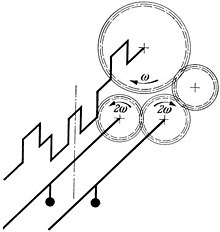Lanchester Compensation
The Lanchester balancer consisting of two balancer shafts , used in -line four-cylinder - four stroke - piston engines to the free mass forces to eliminate second-order. It is named after the British engineer Frederick W. Lanchester (1868–1946).
Problem
R4 four-stroke engines are usually built so that the inner pistons run out of phase with the outer ones. If the outer cylinders (1 and 4) are at top dead center , then the inner cylinders (2 and 3) are at bottom dead center and vice versa. As a result, the first-order inertia forces are balanced and the cylinders fire at regular intervals (180 ° crank angle).
The inertial forces of the second order arise from the fact that the connecting rods are tilted relative to the cylinder axis when the crank drive moves. If the connecting rods are tilted, the distance between the piston and the crank pin, measured parallel to the cylinder axis, is smaller. When the pistons are in their dead centers, the connecting rods are vertical. If, on the other hand, the crankshaft is rotated by 90 °, all connecting rods are at an angle, and the common center of gravity of all pistons is therefore further down than in the dead centers. This common center of gravity thus moves up and down with every half revolution of the crankshaft, and the more the shorter the connecting rods are compared to the crank radius (crank ratio).
How the Lanchester Compensation works
The Lanchester balancer consists of two balancer shafts that rotate in opposite directions and at double the crankshaft speed. A counterweight ( imbalance ) is attached to each of them , the common center of gravity of which moves up and down in phase opposition to the center of gravity of the pistons. The balance shafts must be arranged in such a way that the center of gravity of the counterweights lies in the plane of the cylinder axes and in the middle between the second and third cylinder (dash-dotted line in the figure). The common center of gravity of all parts (piston and counterweights) then practically no longer moves, except for the higher-order parts, which are, however, very weak.
literature
- Stefan Zima: crank drives , Vieweg Verlag, Wiesbaden 1999, ISBN 978-3528131159 .
